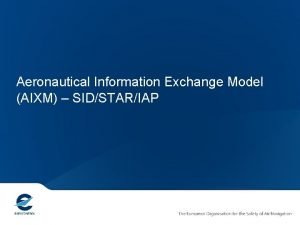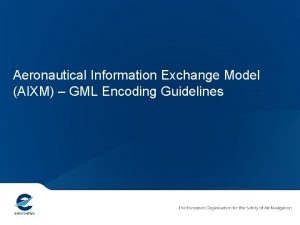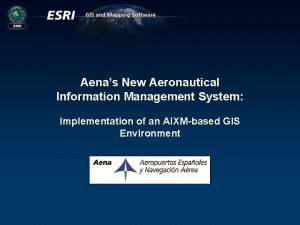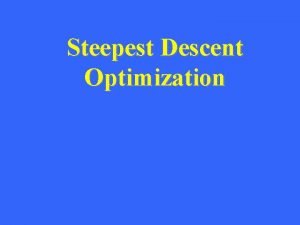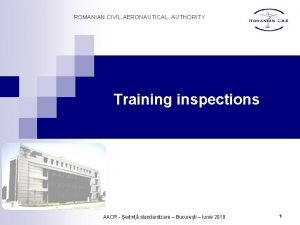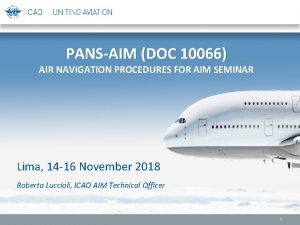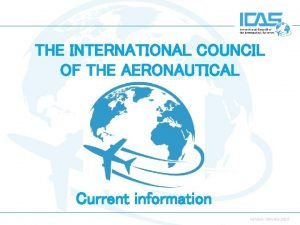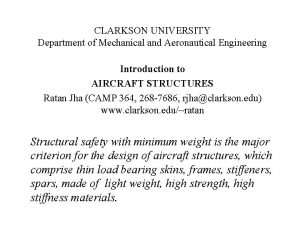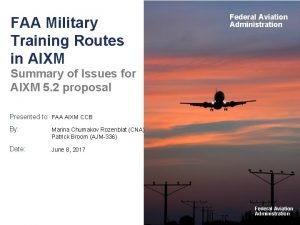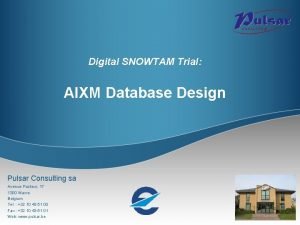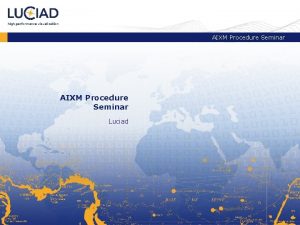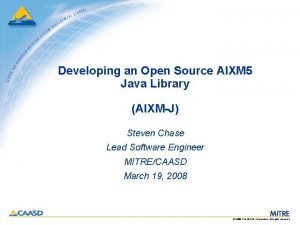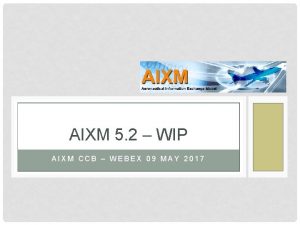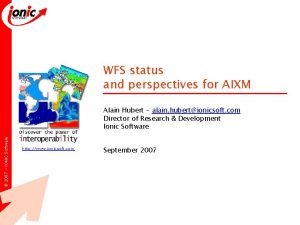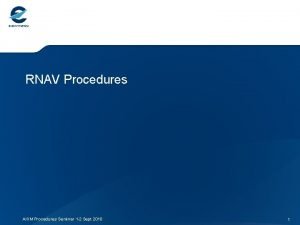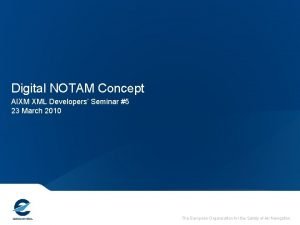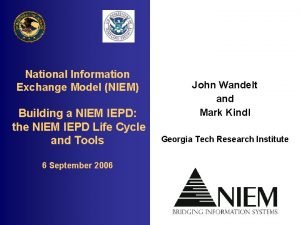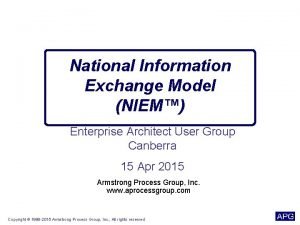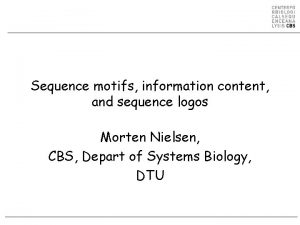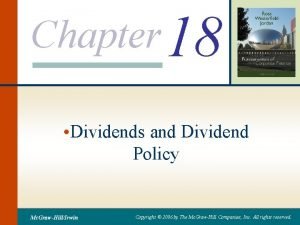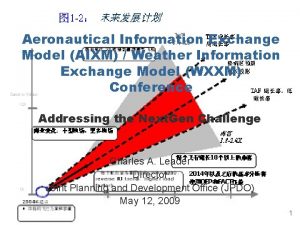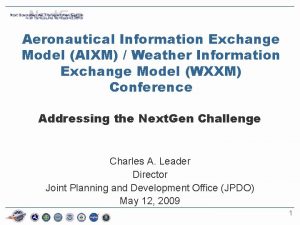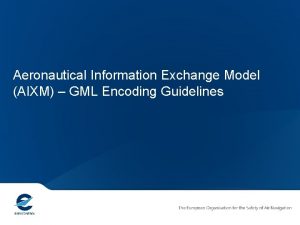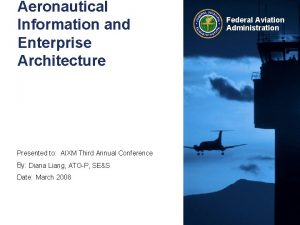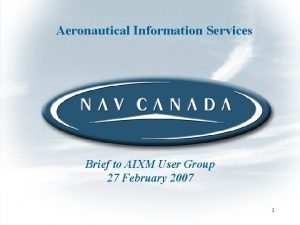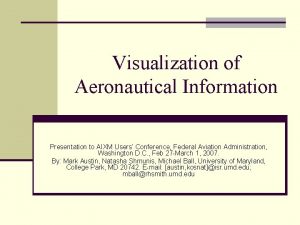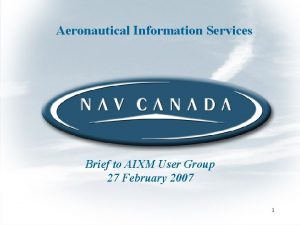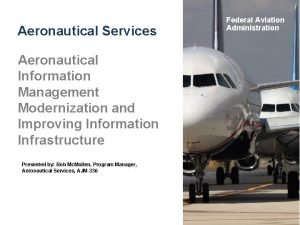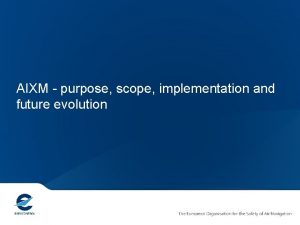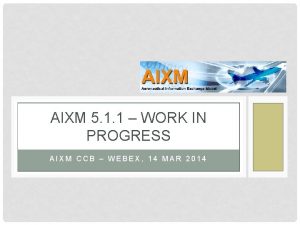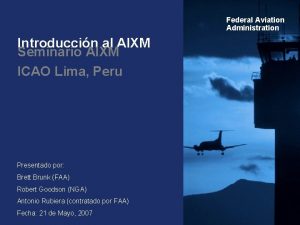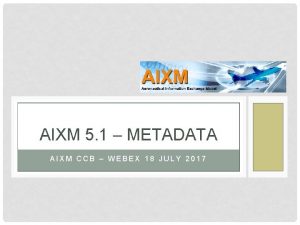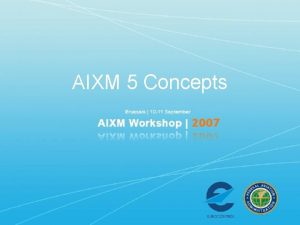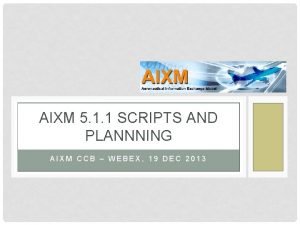Aeronautical Information Exchange Model AIXM SIDSTARIAP Content Context






































- Slides: 38

Aeronautical Information Exchange Model (AIXM) – SID/STAR/IAP

Content • • • Context & History Overview of the Procedure Model Procedure Transition, Segment. Leg and Segment. Point Approach Conditions (minima…) Circling Area MSA TAA Miscellaneous Some open issues

Procedure = SID, STAR or Approach

History of the AIXM Procedure Model • AIXM 3. 3 / AIXM 4. 5: • Objective: provide an encoding for procedure charts, in support of EAD SDO • Based on Arinc 424 -14 • Procedure. Leg was the key of the Procedure model • Some non-Arinc legs (time-based legs PT/FT) were included

AIXM 4. 5 Procedure Model

AIXM 4. 5 Procedure Model

History of the Procedure Model • AIXM 5. 0/5. 1 • Better support the encoding of RNAV procedures published in AIPs • Support the procedure design process • Upgrade the model with recent changes in PANS-OPS and Arinc 424 (FAS Datablock)

History of the Procedure Model • AIXM 5. 0/5. 1 Procedure Model goals • Intended for: • support digital transfer of procedure data from procedure designer to AIS office • support digital transfer of procedure data and further to the data users (data houses, charting office, etc. ); this includes conversion of AIXM data into ARINC 424 • Might be useful for: • Procedure design (with extensions) • Direct FMS encoding? (nobody tried that yet…)

AIXM 5. 1 Procedure Model - Overview Procedure The terminal area procedures and related concepts (MSA, TAA. . . ) Navaids Points Guidance Service, Point Reference, and Segment Points Holding Patterns Service For Information services (ATIS) and ATC services Shared. Surface Assesment

AIXM 5. 1 Procedure Model - Overview Designator SID & STAR: designator (+ name? ) Approach: name + 6 first attributes of class Instrument. Approach. Procedure approach. Prefix = Blank approach. Type = VOR multiple. Identification = X copter. Track = Blank circling. Identification = Blank course. Reversal. Instruction = Blank

AIXM 5. 1 Procedure Model - Overview - Attribute RNAV is used to identify an RNAV procedure - For an approach, attribute approach. Type can also carry the value “RNAV” Connection SID/STAR/Appr -> Runway. Direction is realised through class Landing. Take. Off. Area. Collection

AIXM 5. 1 Procedure Model - Overview

Procedure design vs Procedure encoding • • The AIXM model defines the class Segment. Leg which represents an elementary portion of a Procedure A Segment. Leg is associated to a Procedure. A procedure is designed by attaching several Segment. Leg to the procedure • A Procedure can be divided into a series of Procedure Transitions • More optimised for Procedure Encoding Procedure Design Procedure Encoding

Procedure Transition & Segment. Leg IAF 1 • • • A Procedure can be divided in a series of Procedure Transitions A Transition can be represented as a sequence of Segment. Leg A Transition can be associated with a geographical Curve (for charting and procedure design not intended for flight) WPT 1 WP 4 leg 1 leg 2 IAF 2 IF FAF leg 1 MAP runway WP 3 WP 2 3 “approach transitions” 1 final approach 1 missed approach

Procedure Transition & Segment. Leg • • Approach Transition GEBTI Approach Transition VFA Final Approach Missed Approach Segment. Leg Holding. Pattern

Segment. Leg contains a set of attributes inspired from the Arinc 424 specification Note: It is not mandatory to use Arinc 424 concepts => leg. Path Segment. Leg is an abstract class which is specialised: - 1 st specialisation per type of procedure - 2 nd specialisation per type of transition for approach procedures For a SID For a STAR For an Approach For a missed approach For an approach transition For a final approach

RNAV – Path Terminator Leg Type Terminator Path Constant DME arc Course to Direct Track Course from a fix to Holding pattern Initial Constant radius Track between Heading to A C D F H I R T V A C D F I M R Altitude Distance DME distance Fix Next leg Manual termination Radial termination

Path Terminators 14 RNAV Types • • • • Course to an Altitude Course to a Fix Direct to a Fix to an Altitude Fix to a Manual Termination FM Racetrack Course Reversal (Alt Term) Racetrack (Single Circuit - Fix Term) Racetrack (Manual Termination) Initial Fix Track to a Fix Constant Radius Arc Heading to an Altitude Heading to an Intercept VI Heading to a Manual Termination - CA CF DF FA - IF TF - HA HF HM - VM RF VA -

Course to an Altitude Course is flown making adjustment for wind 090 0 CA Leg Unspecified Position

Segment. Leg & Segment. Point Initial. Leg 1 type = IF Initial. Leg 2 + start. Point type = CF course = 276 course. Type = MAG + end. Point. Reference role = RAD_DME Angle/Distance Indication angle = 96 (276 -180) angle. Type = MAG distance = 9 NM Terminal. Segment. Point Waypoint = NO Navaid Designator = IIF Indicator FACF = Yes Role = IF Terminal. Segment. Point Designated. Point Waypoint = YES designator = GEBTI role = IAF type = ICAO

Segment. Leg - Particular cases Missed. Approach. Leg end. Condition. Designator = ALTITUDE lower. Limit. Altitude = 2000 ft Missed. Approach. Leg end. Condition. Designator = INTERCEPT +distance Distance. Indication distance = 18 NM Navaid designator = TOU

Approach Conditions Approach. Condition final. Approach. Path = STRAIGHT_IN Aircraft. Characteristics aircraft. Landing. Category = C Minima altitude = 218 ft altitude. Code = OCA altitude. Reference = MSL height = 200 ft height. Code = OCH height. Reference = HAT

Circling Area

Navaid +centre. Point Designator = VFA Safe. Altitude. Area MSA safe. Area. Type = MSA Circle. Sector 1 arc. Direction = CWA (clockwise Arc) from. Angle = 104 to. Angle = 284 angle. Direction. Reference = TO inner. Distance = 0 NM outer. Distance = 25 NM lower. Limit = 3000 ft lower. Limit. Reference = MSL Circle. Sector 2 arc. Direction = CWA (clockwise Arc) from. Angle = 284 to. Angle = 104 angle. Direction. Reference = TO inner. Distance = 0 NM outer. Distance = 25 NM lower. Limit = 1400 ft lower. Limit. Reference = MSL

TAA Terminal. Arrival. Area safe. Area. Type = LEFT_BASE +IF Designated. Point designator = LC 406 +IAF Designated. Point Circle. Sector 1 arc. Direction = CWA (clockwise Arc) from. Angle = 83 to. Angle = 173 angle. Direction. Reference = TO inner. Distance = 15 NM outer. Distance = 25 NM lower. Limit = 7100 ft lower. Limit. Reference = MSL Circle. Sector 2 arc. Direction = CWA (clockwise Arc) from. Angle = 83 to. Angle = 173 angle. Direction. Reference = TO inner. Distance = 0 NM outer. Distance = 15 NM lower. Limit = 5000 ft lower. Limit. Reference = MSL designator = RIMOR

Miscellaneous - FAS datablock • The FAS data block is defined for RNAV GNSS approaches with LPV minima (SBAS) Final. Leg guidance. System = LPV Note: The FAS DB can not be encoded as a whole (i. e. in one block) in AIXM 5. 1 (E. g: Airport. ID) Extracted from RTCA DO 229 -D

Recommended navaid Conclusion of AIXM seminar #1

Recommended navaid The current AIXM 5. 1 encoding solution Conclusion of AIXM seminar #1

Recommended navaid Point Reference Role Conclusion of AIXM seminar #1

“Multi-branch” procedures

“Multi-branch” procedures • ICAO Annex 11, Appendix 3 “The coded designator of a standard departure or arrival route instrument or visual, shall consist of: a) the coded designator or name-code of the significant point described in 2. 1. 1 a); followed by b) the validity indicator in 2. 1. 1 b); followed by c) the route indicator in 2. 1. 1 c), where required. ” Example: ADOLA 5 B

“Multi-branch” procedures

“Multi-branch” procedures

“Multi-branch” procedures According to Annex 11, AIPs: multi-branch procedures do not exist? -“common route” transitions have been introduced for FMS database size reasons - AIXM 5 tries to support both views: individual procedures and multi-branch

“Multi-branch” procedures • Procedure encoding workflow with AIXM • Each leg belongs to one procedure • No sequence number because it was assumed that start/end point data is sufficient to identify the order of the segments • VEROR 4 A and VEROR 4 B are two different Procedure instances

“Multi-branch” procedures • Procedure transitions can also be encoded “top-down”, using the pre-defined legs.

“Multi-branch” procedures • Change proposal?

Questions?
 Aeronautical information exchange model
Aeronautical information exchange model Aeronautical information exchange model
Aeronautical information exchange model Aeronautical information exchange model
Aeronautical information exchange model Aeronautical information exchange model
Aeronautical information exchange model Ais aena
Ais aena Invest in aeronautical production in colombia
Invest in aeronautical production in colombia Utm automotive engineering
Utm automotive engineering Aeronautical communication ppt
Aeronautical communication ppt Aeronautical engineering
Aeronautical engineering Romanian civil aeronautical authority
Romanian civil aeronautical authority Pans-aim
Pans-aim High altitude aeronautical platforms ppt
High altitude aeronautical platforms ppt International council of the aeronautical sciences
International council of the aeronautical sciences Clarkson university aeronautical engineering
Clarkson university aeronautical engineering Military training routes
Military training routes Aixm database
Aixm database Aixm software
Aixm software Aixm software
Aixm software Sunafil organigrama
Sunafil organigrama Aixm confluence
Aixm confluence Aixm software
Aixm software Rnav procedures
Rnav procedures Aixm db
Aixm db Niem iepd
Niem iepd National information exchange model
National information exchange model Carrier content vs real content
Carrier content vs real content Dynamic content vs static content
Dynamic content vs static content Virgen de guadalupe
Virgen de guadalupe Real exchange rate formula
Real exchange rate formula Voluntary exchange activity the pearl exchange
Voluntary exchange activity the pearl exchange Gas exchange key events in gas exchange
Gas exchange key events in gas exchange High context vs low context culture ppt
High context vs low context culture ppt Communicating across generational differences
Communicating across generational differences Spatial deixis
Spatial deixis Contoh high context culture
Contoh high context culture Sequence logo information content
Sequence logo information content The information content of dividends refers to
The information content of dividends refers to Information thoughts
Information thoughts Crisp health information exchange
Crisp health information exchange

